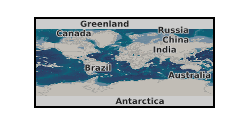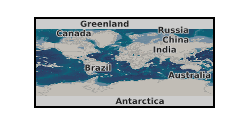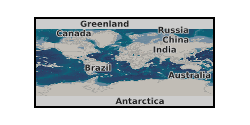Carbon dioxide
Type of resources
Topics
Keywords
Contact for the resource
Provided by
Years
Formats
Representation types
Update frequencies
Scale
-
This dataset contains atmospheric carbon dioxide, oxygen and atmospheric potential oxygen data from the Cap San Lorenzo container ship. A Li-6252 CO2 analyser and Oxzilla II O2 analyser was used for measurement. The UK participation of Southern OceaN optimal Approach To Assess the carbon state, variability and climatic drivers (SONATA) was funded by the Natural Environment Research Council (NERC, grant: NE/P021360/1).
-
This dataset contains atmospheric carbon dioxide and methane measurements taken from Bachok Marine Research Station, Malaysia using Los Gatos Research (LGR) Fast Greenhouse Gas Analyser (FGGA) from 2015 to present. LGR FGGA measures trace concentrations of methane (CH4), carbon dioxide (CO2) and water vapor (H2O) simultaneously in flowing gaseous samples (usually air) at rates up to ≥10 Hz. Backok Research Station is located on the east coast of Malaysia, within 100 m of the waters' edge of the South China Sea. This facility is part of the Institute of Ocean and Earth Sciences (IOES) at the University of Malaya (UM). An atmospheric observation tower has been built on the windward side of the main building, for the specific purpose of studying long range transported pollution, air sea exchange, and coastal meteorology. The UK participation of the Methane Observations and Yearly Assessments (MOYA) project was funded by the Natural Environment Research Council (NERC, grant: NE/N015584/1).
-
This dataset contains carbon dioxide concentration measurements from the British Antarctic Survey's Halley Research Station in Antarctica. The Picarro G2301 analyser was used for the measurement of carbon dioxide and located at the Clean Air Sector Laboratory (CASLab). Data times were averaged from the 1 minute data to provide hourly data sets. The UK participation of Southern OceaN optimal Approach To Assess the carbon state, variability and climatic drivers (SONATA) was funded by the Natural Environment Research Council (NERC, grant: NE/P021360/1).
-

UKCCSRC Flexible Funding 2020. Experimental data are the acoustic emission (AE) signals collected with three AE sensors when CO2 leak from a CO2 storage cylinder under different pressures. '5MPa_20kgh-1' means the data was collected when the pressure was 5MPa and the leakage rate was 20 kg/h. The sampling frequency of AE signals is 3MHz. UKCCSRC Flexible Funding 2020: Monitoring of CO2 flow under CCS conditions through multi-modal sensing and machine learning.
-

This dataset comprises ECLIPSE input decks for a 3D reservoir simulation of the CO2 plume at the Sleipner CO2 injection site. This whole reservoir model is an attempt to history match the growth of the plume observed on seismic data. A seismic velocity and density model derived from the 3D reservoir simulation is also included, together with a series of Seismic Unix scripts to create a synthetic seismic section through the Sleipner reservoir model, for comparison with released time-lapse seismic data.
-

The supporting data for C. Harris et al., 2021, 'The impact of heterogeneity on the capillary trapping of CO2 in the Captain Sandstone', International Journal of Greenhouse Gas Control. We supply experimental and numerical simulation data used in the paper. The supplied codes reproduce each figure. The codes are split into 2 folders, descriptions of each of the folders are given below: 0 - README. This contains detailed instructions on using the supplied files. 1 - Main simulations. This contains the code to produce the main CMG (Computer Modelling Group) simulations outlined in the paper, with various input variable files. 2 - Other figures. This contains the code to produce other figures within the paper which do not rely on numerical simulations, including the experimental data.
-

During the drilling of an exploration well in the 1960s, an underground blowout occurred near Sleen, The Netherlands. During approximately 25 months, near-continuous leakage of large amounts of natural gas was released into the subsurface. After the blowout, the local drinking water production company installed a network of groundwater monitoring wells to monitor for possible adverse effects on groundwater quality at the blowout site. Today, more than 50 years after the blowout, the groundwater is still impaired. Data has been correlated with previously published data by Schout et al. (2018) covering description of geology and well depths. During two fieldtrips (November 2019 & October 2020) water samples were collected from several wells covering: - Bulk gas compositions (methane, ethane, propane, oxygen, nitrogen, CO2, Argon). Bulk isotope compositions of methane (δ13C & δH), carbon dioxide (δ13C) and nitrogen (δ15N). - Methane clumped isotope compositions (ΔCD & ΔDD). - Inorganic parameters (hydrocarbons, anions, cations, DOC, alkalinity, nitrate and ammonium). The dataset was created within SECURe project (Subsurface Evaluation of CCS and Unconventional Risks) - https://www.securegeoenergy.eu/. This project has received funding from the European Union’s Horizon 2020 research and innovation programme under grant agreement No 764531.
-

This study was carried out jointly by the University of Birmingham and the British Geological Survey. The report addresses the feasibility of using novel quantum-technology-based gravity sensors to monitor underground CO2 storage. Of particular interest is the applicability to upcoming near-surface leak monitoring trials that the British Geological Survey will be conducting at its test site. UKCCSRC Flexible Funding 2021: Feasibility study into Quantum Technology based Gravity Sensing for CCS
-

Late (0-250 ka) and middle (1050-1280 ka) Pleistocene boron isotope data from planktic foraminifera (Globigerinoides ruber) and oxygen isotopes data from benthic formainifera (Cibicidoides wuellerstorfi). Boron isotopes measured using multi-collector inductively coupled plasma mass-spectrometry (MC-ICPMS).
-

Isotope tracing data for 14C, 15N and 33P tracing between plants and symbiotic fungi in Lycopdiella inundata, Anthoceros and Phaeoceros sp. and Lunularia cruciata. All plants tested and traced in atmospheric CO2 conditions of 440 ppm [CO2] and 800 ppm [CO2]. Datasets includes total mass of plants and soils, Bq in each component of experimental systems and values in Bq and mg where appropriate.
 NERC Data Catalogue Service
NERC Data Catalogue Service